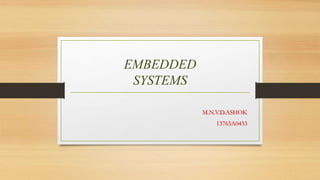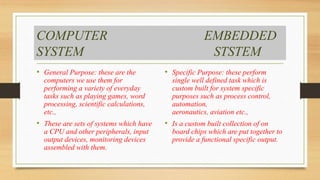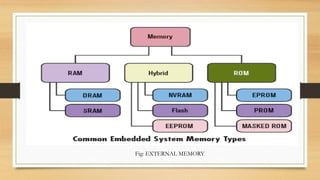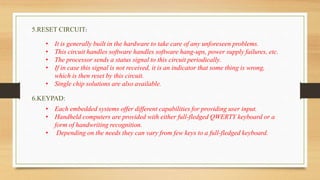Embedded systems
- 1. EMBEDDED SYSTEMS M.N.V.D.ASHOK 13765A0433
- 2. CONTENTS ïžDEFINITION ïžCOMPUTER SYSTEM vs EMBEDDED SYSTEM ïžCATEGORIES AND REQUIREMENTS OF EMBEDDED SYSTEMS ïžDESIGN AND ARCHITECTURE OF EMBEDDED SYSTEM ïžADVANATAGES AND DISADVATAGES ïžAPPLICATIONS AND CONCLUSION
- 3. Like any other computing system, an embedded system is a combination of hardware and software which is custom built for system specific purpose, as the requirements of each system vary considerably.
- 4. EXAMPLES:
- 5. COMPUTER EMBEDDED SYSTEM STSTEM âĒ General Purpose: these are the computers we use them for performing a variety of everyday tasks such as playing games, word processing, scientific calculations, etc., âĒ These are sets of systems which have a CPU and other peripherals, input output devices, monitoring devices assembled with them. âĒ Specific Purpose: these perform single well defined task which is custom built for system specific purposes such as process control, automation, aeronautics, aviation etc., âĒ Is a custom built collection of on board chips which are put together to provide a functional specific output.
- 6. COMPUTER EMBEDDED SYSTEM STSTEM âĒ They are very cumbersome machines such as work stations and mainframe computers. âĒ They are not time critical in their operations. âĒ These are hand held devices which are customized and have eased mobility. âĒ In many of the case they have to be very time critical responding to various real time interrupts.
- 7. COMPUTER EMBEDDED SYSTEM STSTEM
- 8. CATEGORIES OF EMBEDDED SYSTEMS CATEGORIES âĒ Stand-alone embedded systems: which works in a stand-alone mode: taking inputs and giving outputs. Such systems are required in process control, modern entertainment equipment's , automations. EXAMPLES
- 9. CATEGORIES OF EMBEDDED SYSTEMS âĒ Real Time embedded Systems: Sometimes embedded systems are required to carry out specific tasks in a specified amount of time. They can be hard real time (real time constrains has to be strictly maintained) Or Soft Real time (Real time constrains are not so critical).
- 10. CATEGORIES OF EMBEDDED SYSTEMS âĒ Networked Applications: Embedded systems which are need to be connected in a networked environment. Typically one based on TCP/IP or web servers (HTTP).
- 11. CATEGORIES OF EMBEDDED SYSTEMS âĒ Wireless networks that can support high speeds, mobile devices are capable of supporting high data rates, with voice and internet. The special requirements of these devices is threefold: they should have powerful computing and communication capabilities, they should be capable to perform some real time tasks, in addition to non real-time tasks.
- 13. HARDWARE ARCHITECTURE OF EMBEDDED SYSTEMS âĒ An embedded system is built around a processor. âĒ The central processing unit does the necessary computation based on the input it receives from various external devices. âĒ The functionality of the CPU is an embedded system is same as the functionality of the CPU in a desktop, except that the CPU in an embedded system is less powerful. âĒ The processor has limited internal memory, and if this internal memory is not sufficient for a given application external memory devices are used. âĒ The hardware also includes any components that facilitates the user-application interaction, such as display units, keypads etc.
- 17. Fig: DIGITAL SIGNAL PROCESSOR
- 20. 3.LATCHES AND BUFFERS: âĒ Processor based systems need to derive external devices such as LEDs, displays, relays, etc. âĒ The processor does not directly interface with these devices. âĒ Flip-flop logic chips are used to drive external drivers. âĒ These chips hold the processor output data to be send to the external devices. 4.CRYSTAL: âĒ The CPU needs a clock source, and a crystal oscillator generates the clock. âĒ The Crystal is choose based on the clock frequency of the processor. âĒ Micro-controllers provide an on chip oscillator and you connect an external crystal or ceramic resonator. âĒ The clock generation circuitry determines the various states of machine cycles.
- 21. 5.RESET CIRCUIT: âĒ It is generally built in the hardware to take care of any unforeseen problems. âĒ This circuit handles software handles software hang-ups, power supply failures, etc. âĒ The processor sends a status signal to this circuit periodically. âĒ If in case this signal is not received, it is an indicator that some thing is wrong, which is then reset by this circuit. âĒ Single chip solutions are also available. 6.KEYPAD: âĒ Each embedded systems offer different capabilities for providing user input. âĒ Handheld computers are provided with either full-fledged QWERTY keyboard or a form of handwriting recognition. âĒ Depending on the needs they can vary from few keys to a full-fledged keyboard.
- 22. 7.ADC AND DAC:
- 23. 8.APPLICATION SPECIFIC CONTROL CIRCUITRY:
- 24. 9.DISPLAY UNITS:
- 25. 9.COMMUNICATION DEVICES: âĒ Embedded Systems need to interface with the external devices, thus they need communication interfaces. âĒ Most processors provide a serial interface to send and receive data in serial form. Networked embedded systems are provided with Ethernet interface. âĒ Mobile phones and handheld computers are provided with a number of communication interfaces as such as serial, parallel, infrared, Bluetooth, and USB(Universal Serial Bus). 10.PROGRAMMABLE LOGIC DEVICES: âĒ The manifold requirements are met using PLDs(Programmable Logic Devices). Using design automation tools such as Verilog and VHDL. âĒ This Single chip can be Programmable Logic Device (PLD), Field Programmable Gate Array, Programmable Array Logic (PAL). âĒ Major Suppliers are Axel, Adaptive Silicon, Altera, Atmel, Cypress Semiconductors, Quick Logic, Transcend and Xilinx.
- 26. Fig: OVERVIEW OF AN EMBEDDED SYSTEM
- 27. ADVANTAGES OF EMBEDDED SYSTEMS Low cost. Small size. High reliability. Fast operations. Easy to manufacture. Fewer interconnections. DISADVANTAGES OF EMBEDDED SYSTEMS Hard to maintain. Doesnât evolve with technology improvement. Hard to carry files from one machine to other. Hard to backup embedded files.
- 28. APPLICATIONS OF EMBEDDED SYSTEMS Fig: CUSTOMER APPLICATIONS
- 29. Fig: CONSUMER ELECTRONICS Fig: BIOMEDICAL APPLICATIONS
- 30. Fig: DATA COMMUNICATION Fig: DYNAMIC DISTRIBUTED SYSTEMS
- 33. CONCLUSION: âĒ Now a days its implementation is faster. âĒ Its development is necessary to our future. âĒ These type of systems emerges a new revolution in communication and digital signal processing. âĒ It is cheap and best.

































